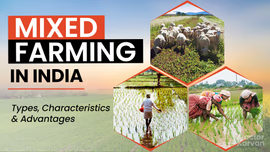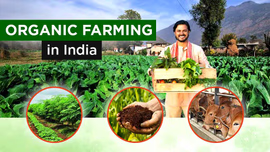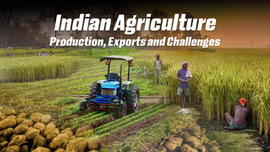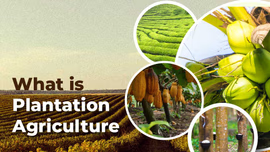Terrace Farming in India: Cultivating a Sustainable Future

From the ancient times, people living in the hilly areas in India have been practicing terrace farming where they shaped the land into stepped field for the cultivation of crops. This blog delves into the importance, types, methods and benefits of terrace farming along with the major crops grown in this farming.
Table of Contents
- What is Terrace Farming?
- What are the Different Types of Terrace Farming in India?
- What are the Different Methods of Terrace Farming?
- Which Crops are Grown in Terrace Farming?
- What are the Benefits of Terrace Farming?
- Conclusion
What is Terrace Farming?
Terrace farming is a method of growing crops on the hillsides by planting them on terraces (flat areas or farmlands) created through cutting of the slopes. These terraces resemble a series of steps, so it is also known as step farming. It is one of the most practiced types of farming in India.
Terrace cultivation is one of India's most practiced types of agriculture in hilly regions. The main areas where it is practiced in India are Kashmir Valley and Northeast, the Himalayan regions, and certain areas of the Western Ghats.
What are the Different Types of Terraces?
Broad-based Terraces, Bench Terraces and Stone Terraces are different types of terraces made in the terrace farming. Let’s discuss each in detail:
Broad-based Terraces: Broad-based terraces, as the name suggests, are wider terraces often used in gentler slopes. This is one of the popular types of terraces in India where ridges are constructed with the ploughs. They slow down the speed of water and reduce erosion. Crops like rice and maize can be grown in this type of terrace farming. The two types of broad-based terraces are Graded terraces and Level terraces.
Bench Terraces: These are the most common types of terraces in India where land is shaped into benches or flat surfaces to reduce the slope of hills. This is the best type of terrace farming where the soil erosion is high. This is best suited for paddy cultivation. Levelled and Tabletop terraces, Inward sloping terraces and Outward sloping terraces are the sub types of bench terraces.
Stone Terraces: In some hilly regions, stone walls are constructed to support the terraces. These terraces help retain the soil and slow down water runoff.
What are the Different Methods of Terrace Farming in India?
There are three terrace farming methods: Bench Terracing, Contour Terracing, and Parallel Terracing. Let’s understand each of these terrace farming methods below:
Bench Terracing
Bench terracing is a method of creating a series of steps called "benches" by cutting the slopes of the hill. The benches are flat areas that look like staircases. The main goal of this method is to reduce the slope of the hillside to reduce the velocity of water runoff and thus prevent soil erosion.
The main components of bench terracing are:
- Terrace bench
- Riser slope
- Shoulder Bund
The bench terracing can be further classified into hill-type bench terraces, irrigated bench terraces, and orchard bench terraces. Further, bench terracing is ideal for growing crops like paddy and potatoes.
Contour Terracing
In this method, terraces are constructed along the natural contour lines of the hill slopes. They help decelerate the water flow down the slopes. It is also called contour ploughing.
To construct such terraces, contour lines are mapped that follow the natural shape of the hill slopes. The contours are lined with geotextiles and filled with rock, stacked, or placed to form a structure resistant to soil erosion. These terraces comprise pointed rows and grassed waterways.
Further, this method has ditches and ridges running perpendicular to the hill slope. They follow the hillside's natural shape. Thus, they do not alter the landscape as compared to bench terracing.
Parallel Terracing
Parallel terracing is the easiest way to cultivate land as it eliminates the need for contour lines, as in contour terracing.
In this method, the terraces are constructed parallel to each other and are in the direction of field operation. Further, the parallel terraces can have a gentle slope or flat-like benches.
Which Crops are Grown in Terrace Farming?
- Rice and wheat
- Maize and barley
- Pulses and millets
- Tea and coffee
- Vegetables and fruits
- Spices
What are the Benefits of Terrace Farming?
Soil conservation, water conservation, increased crop yield, etc. are some benefits of Terrace farming. Let’s discuss more benefits in detail below.
- Soil Conservation: They help prevent soil erosion in hilly areas by reducing the slope.
- Water Conservation: They help conserve water and protect the water quality.
- Additional Land: They create additional arable land in hilly areas where the availability of flat land is limited.
- Promoting Biodiversity: Terraces, by supporting the cultivation of different crops, can help promote biodiversity.
- Sustainable Practices: They allow efficient use of water to promote sustainable agricultural practices.
- Improving Crop Yield: They improve crop yield by conserving soil and water.
Conclusion
Terrace farming is not just growing crops, but it is also a way to a sustainable life. It provides immense benefits to the India’s overall agricultural sector. It improves land productivity otherwise the land on hilly regions would remain an unstable farmland. It also provides economic security for farmers. Also, Terracing is an effective method to reduce soil erosion in hilly areas. Terraces act as land intercepts and reduce the slopes of the hill. The hilly regions remain more levelled with terraces. By embracing terrace farming, farmers can transform their living and promote sustainability.
Frequently Asked Questions On Terrace Farming in India: Cultivating a Sustainable Future
1. What is terrace farming?
Terrace cultivation is a farming method wherein crops are grown along the hillsides on graduated terraces created by cutting the slopes.
2. How does terrace farming prevent soil erosion?
Terraces by working as intercept to the hill slopes reduces the slopes. As a result, the water runoff is reduced, and soil erosion is checked.
3. How is terrace farming done?
Terrace farming is done by creating farmlands on the hill sides. Depending upon the terracing farming system, farm machinery can be used for cultivation.
4. Terrace cultivation is practiced in which states in India?
Terracing farming system is prevalent in the hilly states of Uttarakhand, Himachal Pradesh, and North-Eastern states. It is also prevalent in certain areas of Western Ghats.
5. Why is terrace farming done in hilly regions?
Terrace farming is done in hilly regions because of the irregular landscape, which are not fit for farming. Also, due to less retention of water and high soil erosion, this farming practice is preferred in hilly regions.
6. Why is terrace farming important?
It helps conserve soil, protects water quality, and enhances crop yield.


Related Blogs












